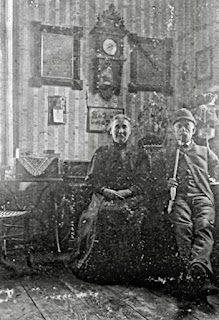Every picture tells a story, No. 19
This photo of Karl Düsselmann (1841-1927) and his wife Elisabeth Imig (1851-1924) strikes me as unusual as it appears to have been taken informally at their home, almost as a snapshot, without the slightest worry about the cluttered background. Did they perhaps know an early amateur photographer?
(this version now improved with a little magic from a helpful twitter friend
compare and contrast versions in my tweet and the replies to it)
Funnily enough, we still have a couple of frames looking a lot like those two on either side of the clock. At the time of Karl's death, his peripatetic son Julius happened to be geographically close, so he may well have inherited those and passed them down to us. It's a shame we can't see who or what's in those frames and the images below, with better quality, this might have been a chance to glimpse at earlier generations of whom we have no photos at all.
Karl Düsselmann (sometimes also appearing as Carl and/or Düselmann) came from the Krefeld clan, which had prospered in the textile industry of that town. He was one of the 13 children that were divided into teams by confession: all six boys grew up protestants (like their dad) and all seven girls became catholics (like their mum). This confessional split even applied to Karl and his twin sister, Maria (1841-1932). Maria married a Heinrich Wilhelm Schürenberg and had five children - about whom we know nothing because they were on the other side of the divide.
After his military service (likely to have been 1861-64, followed by three years as a reservist) and likely involvement in several wars (see below), Karl was a Werkmeister (foreman).
Elisabeth came from the Imig clan in Simmern. Several of her brothers had moved to the lower Rhine area (earlier generations of Imigs had been involved in a failed attempt to emigrate to the New World which ended up in a new settlement on the lower Rhine, not sure if these two moves have a causal connection). Some of the brothers were quite successful there, so I am guessing Elisabeth may have used them to move to the area and find herself a husband there.
Their descendants are listed here. Briefly, Karl had one son (also called Karl) from an earlier marriage, who emigrated to the US in 1892 and had two sons there who were both born in New York. Karl and Elisabeth then had six children, but we have no photos of them with any of their children. Five of them got married and we do have photos of each one with their spouse. The oldest daughter married a Dutchman and ended up in the Netherlands, and one of the sons emigrated to the US with his family in 1924. Overall, our happy couple had 15 grandchildren.
Here's a later (and clearer) portrait of the couple:
It looks like Karl got some military medals to show off. As he was born in 1841, he could have been involved in Prussia's short wars against Denmark (1864) and Austria (1866), which both fell into his three year period as a reservist, and possibly also in the one against France in 1870/71. Don't have the resolution to get any more info from the medals, they appear to be 5 of them, from left to right: big round, small round, cross, big round, flat/wavy.
Thinking of those 5 medals and forgotten military exploits in the wider context of the Krefeld clan, I'm getting the impression that the Düsselmann Y chromosome appears to be linked to a taste for risk taking (slightly surprising in a town and family thriving on spinning and weaving), see also: Julius's rollercoaster of a career; Karl's brother August was the founding director of the Krefeld fire brigade on it becoming a professional force in 1890; August's son Walter smuggled arms for Ireland's Easter Uprising, survived the sinking of the Volturno and disappeared during WW2; and August's son Wilhelm was also a seafarer and died in a road accident. Might explain that, inspite of numerous male offspring over several generations, there aren't all that many carriers of the name around today. Then again, who knows what descendents in the US have done to the name to make it pronouncable in American English.
This photo is also on flickr.
Every picture tells a story series so far:
- string quartet Wuppertal Elberfeld 1927
- greetings from Adamsweiler
- Gastwirthschaft Ferd. Weirich
- quartet times three
- Neumühl 1923
- Tangermünde railway station 1889
- a singing lesson
- bei Wilhelm Geppert
- a bakery at Lorsch 1900
- Consumgeschäft von Julius Düsselmann
- Hanna and Ruth
- a young chemist
- school's out at Reichenstein, 1886
- a patchwork family in East Prussia
- the case of the missing grandmother
- checkpoint Glaner Brücke 1929(ish)
- finding Mimi
- five sisters, five decades
- happy at home
Alternatively, you can use this twitter thread as an illustrated table of contents.
In a somewhat roundabout way, this series relates to my research for the family history music memoir I've now completed..

















No comments:
Post a Comment